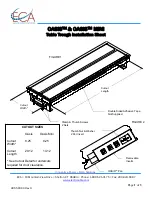
4. Theory of Operation
4-40
An RS232 port
driver changes the serial data logic level signals to RS232 levels.
A ribbon cable carries data to a DB9 connector on the support housing. The
RS232 port is used in factory troubleshooting only.
The air detector electronics
(OEM circuit boards) are mounted directly to the
daughter board. Two (2) detectors are used in the system, one for fluid out
detector and one for in-line air detector. They are the same detectors except one
has a larger slot to be used with pump tubing and smaller slot for patient line
tubing. The new version of the in-line air and fluid out detectors has the built-in
electronics so the electronic boards are not needed.
The air detector
utilizes the characteristics of high frequency acoustic energy to
detect the presence of air, air bubbles, and foam within fluids passing through the
tubing. The tubing is pressed into the slot of a sensor containing piezoelectric
crystals. The piezoelectric crystals send and receive pulses of ultrasonic energy
through the tubing and the fluid. Sound travels at a slower rate through air than it
does through liquid. The tubing must be firmly pressed into the slot of a sensor
to assure adequate acoustic coupling between tubing and the sensor. The two
(2) air detectors are 3/8” OD tubing for fluid out detector and 5/16” OD tubing for
patient line air detector.
The sound circuit
drives a piezoelectric sound sensor with a 30volt pulse signal.
The operator can adjust, the pulse width, to increase or decrease the sound
amplitude in the service mode.
The door status
(latch or unlatch) is sensed by a Hall effect device strategically
mounted on the daughter board behind the door handle, which has a magnet
embedded in it.
The ambient temperature circuitry
measures the ambient temperature of the
daughter board. This is accomplished with an LM45 precision centigrade
temperature sensor. This device requires no calibration and is accurate to ± 2ºC.
















































